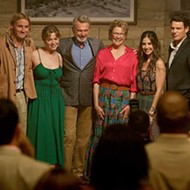SLO Film Fest 23: Reviews for March 16-18
[{
"name": "Ad - Medium Rectangle CC01 - 300x250",
"id": "AdMediumRectangleCC01300x250",
"class": "inlineCenter",
"insertPoint": "8",
"component": "2963441",
"requiredCountToDisplay": "12"
},{
"name": "Ad - Medium Rectangle LC01 - 300x250",
"id": "AdMediumRectangleCC01300x250",
"class": "inlineCenter",
"insertPoint": "18",
"component": "2963441",
"requiredCountToDisplay": "22"
},{
"name": "Ad - Medium Rectangle LC09 - 300x250",
"id": "AdMediumRectangleLC09300x250",
"class": "inlineCenter",
"insertPoint": "28",
"component": "3252660",
"requiredCountToDisplay": "32"
}]

AGE OF CONSEQUENCES
What’s it rated? NR
What’s it worth? Streaming
Where’s it showing? March 16 at 10 a.m. at Downtown Cinemas and 4:30 p.m. at The Palm
Age of Consequences takes an ambitious and dramatic look at the various ways climate change poses a destabilizing threat to our increasingly interconnected societies and economies.
Produced and filmed from a militaristic angle of national security, the documentary moves through nine themed chapters, taking the viewer around the world from China to the Arctic. The 80-minute journey is alarming, but over-produced and exhausting. The central message is driven home at the very start: Climate change isn’t just about a warmer earth. Its consequences will affect nearly every facet of life and society, including the availability of natural resources like food and water that will create or exacerbate conflicts across the world as a result.
The film takes us through a variety of past crises, like droughts in Russia, China, and Africa and Hurricanes Katrina and Sandy in the U.S., to demonstrate climate change’s already felt impact. Incentives to address the crisis are, in some ways, lacking, especially in the entrenched fossil fuels economy, which the film argues stands to benefit from the melting arctic where much of the world’s fossil fuel sources remain.
Instead of being an inspiring call to arms, the documentary is practically crushing in its exhaustive and harrowing presentation. (80 min.)
—Peter Johnson
BIG SONIA
What’s it rated? NR
What’s it worth? Full Price
Where’s it showing? March 18 at 10 a.m. at Downtown Centre; March 19 at 3 p.m. at The Palm
Pick | Grand life lessons are often found in small packages, or in Sonia Warshawski’s case, 4-feet and 8-inches. Big Sonia is a documentary about Warshawski, one of the last known Holocaust survivors in Kansas City who shares her personal story with students, prisoners, and ex-cons. She publicly shares her story in the hopes of inspiring others to not let their pasts define their futures.
The documentary reveals heart-wrenching testimony of hiding from Nazi soldiers in a hole under a bed at the age of 13 in Miedzyrzec, Poland. She was separated from her family, with only her mother at her side when they were taken to multiple concentration camps. At 15, Warshawski recounts watching her mother disappear behind the doors of a gas chamber with only an orange scarf to remember her by—a scarf she keeps to this day.
The past and present are woven together when her three adult children talk about being raised by parents who both lost all their family members to the Holocaust. The film really depicted an appreciative woman who cared deeply for the people in her life and knew the fear of it being taken away.
Warshawski currently keeps herself busy by keeping her late husband’s business, John’s Tailoring, up and running. Through personal testimonials and those of her customers, Warshawski’s spunky personality and business keep her from thinking about the terrors she’d been through. Nearing her 90s and the closure of her shop, Warshawski struggles with the idea of retirement, but even the closure of her store doesn’t keep the positive energy from radiating through her. (93 min.)
—Karen Garcia
THE END OF THE ROAD
What’s it rated? NR
What’s it worth? Matinee
Where’s it showing? March 16 at 4 p.m. at the Fremont; March 18 at 4 p.m. at The Palm
Pick | After the recent election, the idea of moving out of the U.S., packing up, and heading to Canada is a little more real.
The End of the Road is a documentary about just that. The film tells the tale of the a group of young and idealistic Americans who left their country in the 1960s and ’70s, and found their way to the tiny rural township of Lund in British Columbia. There, the prototypical “hippies” lived rough off the land, smoked dope, and tried to live authentically by building a community in their new surroundings.
They came from everywhere. New York, Pennsylvania, Texas. Young sons and daughters of the flower power generation, many of whom had grown disillusioned with the presidency of Richard Nixon and the ongoing Vietnam War. Many were actively dodging the draft. The story is primarily told through eyes of the current and former residents, and intercut with footage from the acid-drenched salad days of Lund. It jumps between these hazy good old days to more recent footage of many of the group getting together for a reunion celebration.
SLO residents will really get a kick out of this film, which incudes former Lund residents like former SLO Mayor Jan Marx and her husband, Steven. Listening to the couple wax philosophic about the hippy-dippy, free-wheeling ideals that brought the young couple to Lund while living in a city that’s banned growing pot, loud music and parties, and smoking pretty much anywhere adds an extra entertaining level of ironic charm to the movie. (120 min.)
—Chris McGuinness
FERESHTEH: DAUGHTER OF AHMAD
What’s it worth? Full price
When’s it showing? March 16 at 1 p.m. at the Fremont; March 19 at 3:30 p.m. at the Mission Theatre
Pick | Fereshteh has all of her father’s (Ahmad) debt weighing her down. He’s in prison for—what I think is, it’s never made explicitly clear—supposed less-than-savory business practices that resulted in all that debt. His family maintains throughout the movie that he hasn’t done anything wrong; it was his business partner who was shady and threw Ahmad under the bus for everything that went wrong with their company and the Iranian economy.
Throughout the entirety of the film, Fereshteh and her mother are constantly scraping money together to pay off the next creditor and to buy food. The family was forced to move from a life of grandeur to one of abject poverty; they can’t even afford to send the youngest to school, and Fereshteh’s mother sells off appliances for cash.
This is an Iranian film, set in Tehran, with beautiful images of the main thoroughfare at night. As someone of Iranian descent who has visited Iran, it made me smile to see something that reminds me of time spent with my mother’s family. It also made me sad to think that my family is struggling to understand how to deal with President Donald Trump’s latest travel ban against Iran. The director of this film, Hassan Ahkondpour, was affected by Trump’s initial travel ban against citizens from seven countries, including Iran. He couldn’t attend the SLO Film Fest, which he was planning to do.
I would encourage you to watch the film for a little peek into Iran, even if it’s a fictional peek. Because, although it’s definitely a film about one family’s struggle to deal with a life-changing shift, it’s also one containing undercurrents that question Iranian politics and societal norms.
News broadcasters on the TV inside the family’s shabby apartment are constantly talking about the sanctions levied against Iran because of its nuclear program—with the government attempting to defend its decision to pursue nuclear strength, even though Iran’s economy is hurting. And although Ahmad is in jail, the women of his family have to wait for his word to go to the bank for a loan that will pay off one of his creditors.
In the end, one of the creditors attempts to pressure Fereshteh into making a decision that could affect the remainder of her life as a trade-off for money and getting her father out of jail. (90 min.)
—Camillia Lanham
KHOJ (THE LOST)
What’s it rated? Not rated
What’s it worth? Full price
Where’s it showing? March 17 at 1:30 p.m. at The Palm; March 18 at 7 p.m. at Mission Theatre
Pick | This crime thriller filmed in the hills of India follows a precinct police inspector who’s searching for the missing wife of a local doctor. Neighbors complain about hearing screams from the doctor’s house, and when the inspector goes to investigate, the doctor claims his wife is under his medical care and she can’t come to the door; however, the next morning the doctor files a missing person report.
The inspector is mistrustful of the doctor, who can only produce one small photo of his wife, and after looking through the doctor’s house, the inspector comes to the conclusion that no woman has been living there. Why is the doctor lying? Does he have a wife at all?
What follows is a thorny and seedy tale about infidelity, revenge, and blackmail concerning the doctor, his wife, and how they were befriended by a couple from their neighborhood who upended their lives. Told in a nonlinear plotline that reveals its secrets slowly, the story is filled with tension and menace. It’s effectively paced, well acted, and a fascinating glimpse into an unfamiliar culture.
The cinematography by Ripon Chaudhury is especially good, with haunting night scenes in foggy forests and carefully lit interior scenes. Writer-director Arka Ganguly has crafted a story that keeps you guessing right up till the end, and the ending itself is terrifying indeed.
If you’re looking for an effective thriller with enough twists and turns to tie you in knots, Khoj delivers (in Bengali and English; 116 min.)
—Glen Starkey
THE LOST CITY OF CECIL B. DEMILLE
What’s it rated? NR
What’s it worth? Matinee
Where’s it showing? March 18 at 1 p.m. at Downtown Centre; March 19 at 10 a.m. at Mission Theatre
Pick | More than a century ago, an epic film was made in the dunes of Guadalupe. Rows of regal sphinxes heralded the massive façade of an Egyptian temple, hundreds of feet tall, and scores of actors poured down the desert avenue.
Hollywood’s Cecil B. DeMille agreed with Santa Barbara County to haul away the massive set piece when he completed filming his 1923 silent production of The Ten Commandments, but that never happened. Instead, the set pieces were pushed over, the sphinxes and all other detritus was pushed into ditches, and the dunes sand covered everything for a time.
Decades later, rumors of the buried remains met the ears of filmmaker Peter Brosnan. A friend of his pointed to a cryptic line in DeMille’s autobiography, which hinted at a secret submerged in the dune sands. That was the beginning of Brosnan’s quest to make the documentary, The Lost City of Cecil B. DeMille.
Little did Brosnan know that it his struggle to unearth some of the artifacts there would be decades long.
The film is a documentary about a documentary, sharing each productive time period and move forward that Brosnan made, as well as his setbacks, from a disorganized Santa Barbara County permitting office to lack of funding for the excavation.
The Lost City of Cecil B. DeMille fleshes out the story of the Guadalupe production of The Ten Commandments well. Brosnan had been at the task since the 1980s, and captured a number of interviews with Santa Maria Valley notables, including a few old timers who either helped with the film or were in it as extras, like Ernest Righetti, Clarence Minetti, and Sam Donatti.
The choice to also chronicle DeMille’s efforts in producing the 1956 version of the film lengthens the documentary considerably, but giving tribute to a director whose films lasted hours and began with orchestral overtures takes time, and The Lost City of Cecil B. DeMille is a fitting and informative tribute. (89 min.)
—Joe Payne
NADIA COMANECI: THE GYMNAST AND THE DICTATOR
What’s it rated? NR
What’s it worth? Full Price
Where’s it showing? March 18 at 10:15 a.m. at Downtown Centre; March 19 at 10:15 a.m. at Mission Theatre
Pick | Everyone’s heard of Nadia Comaneci, the Romanian gymnast who was the first ever to score a perfect 10 in the 1976 Olympics in Montreal. It was such an unprecedented event that the scoreboard wasn’t even programmed to display 10, so instead her perfect score showed up as a 1.0, causing some confusion.
That victorious moment and so much more is revealed in the documentary film Nadia Comaneci: The Gymnast and the Dictator. Featuring interviews with Nadia’s teammates and family members, her famous coach Bela Karolyi, and also voice overs of an actor reading excerpts from Comaneci’s autobiography, Letters to a Young Gymnast.
Comaneci brought so much attention and popularity to the sport of gymnastics that it’s easy to assume that her life was a fairy tale, but the film shows that’s not the case at all. After her big victory, Comaneci was honored by her country in a ceremony, but then largely ignored unless communist dictator President Nicolae Ceausescu wanted to trot her out for the media or international leaders. Still, in excerpts from Comaneci’s book, it’s revealed that the young gymnast and her family struggled with things like having enough food to eat and the Olympian still had to wait in line for bread and other necessities like the rest of Romania. Comaneci was routinely followed by members of Romania’s secret service and wasn’t allowed to leave the country unless it was for gymnastics competitions.
Through the excerpts and interviews with people close to Comaneci at that time, you start to get a sense for who the gymnast really was, a tough kid who felt trapped by her circumstances and government in spite of her own success. The glaring piece that’s missing from the film is an interview with Comaneci. But the former Olympian has stayed very tight lipped about her relationship with her home country’s government since defecting to the United States in 1989, even though she’s finally gotten her fairy tale ending, marrying Olympian Bart Conner and starting a family and working to promote gymnastics in the U.S. I guess the weight of the Iron Curtain never really leaves those who lived beneath its shadow. (55 min.)
—Ryah Cooley
REBELS ON POINTE
What’s it rated? NR
What’s it worth? Full Price
Where’s it showing? March 17 at 4 p.m. at the Fremont; March 19 at 3 p.m. at The Palm
Pick | Ballet is an art form that takes itself so, so seriously. Which makes it all the more delightful to see it taken down a peg (in a loving way) in Bobbi Jo Hart’s documentary Rebels on Pointe.
Traditionally, in professional ballet men don’t dance on pointe and their primary role is as the dashing prince who literally leaps in to save the day. But in 1974, a group of male (and yes, gay) ballet enthusiasts in New York City decided to turn notions of femininity and masculinity in ballet on their heads by forming Les Ballets Trockadero de Monte Carlo, an all-male drag ballet company.
The film guides us through this fabulous world. Make no mistake, these men truly love ballet (and tutus and makeup), but they also love acknowledging the farce of it all with literal winks and on stage diva tantrums.
While once thought of as taboo, today the company has performed in more than 500 cities in 33 countries, and has an international cult following. The film goes beyond the stage, digging into the dancers the company lost during the AIDS crisis in the ’80s and getting into the personal lives of the performers as well. We see one of the company’s three married couples exchange their vows and we see another dancer talking with his parents about their journey to accepting his sexuality and career. There’s the normal dancer woes too, like struggling to maintain a normal life when you’re on tour 200 days a year and coming to grips with choosing a career where most retire at 40, tops.
Rebels on Pointe is an intimate look into the lives of the men boldly daring to take ballet where no one else has. (90 min.)
—Ryah Cooley
REFUGEES: ENEMIES OR VICTIMS?
What’s it rated? NR
What’s it worth? Full Price
Where’s it showing? March 16 at 4:15 p.m. at The Palm; March 17 at 4:30 p.m. at The Palm
Pick | Nearly 5 million Syrians have fled their home country in the face of destruction from civil war and the rise of ISIS. Yet, not even 15,000 Syrian refugees have been allowed into the U.S. Refugees: Enemies or Victims? is a potent and timely documentary that lays out the Syrian crisis and its horrific reality, charts how the U.S. and the broader international community has responded, and gives the crisis a historical context.
Based on interviews with refugees, activists, faith-based organizations, and scholars, Refugees makes a compelling case that the U.S. is turning its back on refugees in a historic way, during the worst refugee crisis since World War II. Director, writer, and editor Terence Donnellan does a nice job unraveling the complexities of the situation and discussing unflinchingly the roles Islamophobia and fears of terrorism in America has played in our response.
The film draws extremely interesting parallels to past times of world crisis and offers critiques of when the U.S. was particularly welcoming to refugees (Vietnamese during the Vietnam War) and when it was particularly discriminatory and fearful of the supposed dangers (Jewish refugees and Japanese-Americans during World War II).
Refugees also explores the diverse religious makeup of Syria, driving home important points about the relationships between Muslim and Christian Syrians, how people of both religions are victims of the crisis, and how ISIS is a political perversion of Islam that has impacted Muslims as much as any other religious group. (50 min.)
—Peter Johnson






